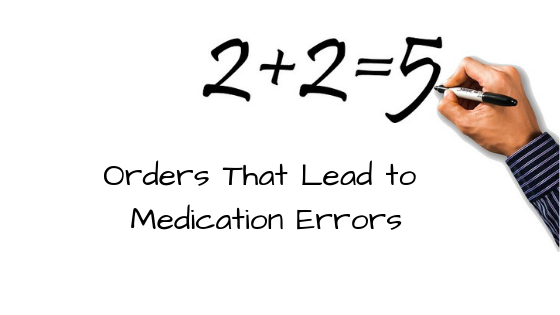Whenever humans are involved in a process, there is bound to be errors. As a clinical pharmacist who helps patients and other healthcare professionals safely use medications, I see a lot of mistakes. In long term care and assisted living facilities I would help monitor medication errors that occurred and try to come up with interventions to reduce the risk of an error happening again.
From experience reviewing thousands of medication errors, I can tell you that these types of orders you are writing can set yourself or a colleague up for failure.
Half-tab orders
Half-tablet or sometimes ¼ tablet orders happen on a fairly regular basis. There may be a very good reason to do this. Cost of the medication can be a potential reason. Another reason I see this order is if a particular drug strength is not available. Alternatively, a well-intended provider may want to use up a current supply of a higher dose that the patient has. It may also be a narrow therapeutic index drug. I’m not saying these aren’t good reasons to use this ordering strategy, but I will say you are likely increasing the risk of an error.
Take a look at this order. Levothyroxine 125 mcg tablet. Take one-half tablet once daily.
It is natural to see the 125 mcg tablet. In this situation, the provider reviewed the most recent TSH which was slightly elevated at 8.2. They wanted to slightly increase the dose. They looked at the med list to see what they were on and increased the dose to 150 mcg once daily. The provider overlooked the one-half tablet. This is easy to do if you are in a hurry. You can find more clinical practice pearls and case examples like this in my Audiobook – Pharmacotherapy (Audible allows you to get your first book for free!)
Every Other Day or Alternate Days
I don’t know if you have ever tried to remember something every other day, but it is actually really hard. Patients can really struggle with this. I would strongly encourage you to avoid every other day, every third day, etc. type of dosing. Adherence is going to be challenging for our patients and there is also the risk of pharmacy, nursing, another provider, or the patient misinterpreting the order as well.
Multiple Tablets
Gabapentin 100 mg; Take 3 capsules three times daily. There’s a couple of reasons to avoid orders like this. The first: the directions can possibly be overlooked and the individual simply taking the 100 mg dosing. The other big reason is pill burden. Patients can get overwhelmed by the number of pills they have to take, and orders like this can pile on to this problem. In this situation, you’ve got a patient taking 9 capsules per day for just one medication. If you are interested, here’s the biggest medication list I’ve seen in my career. This patient was on 50+ medications! I think when you read through the list you’ll get a sense of feeling overwhelmed. You will also get a sense of how orders like this gabapentin one can really add on to pill burden.
There may be rare instances where you feel like you need to write a type of order mentioned above, but I strongly encourage to attempt avoiding this whenever possible. The likelihood of errors, adherence problems, and your patients getting hurt increases with increasing order complexity.
- 30 medication mistakes PDF
- 18+ Page Drug Interaction PDF
- 10 Commandments of Polypharmacy Webinar based on my experiences in clinical practice



0 Comments